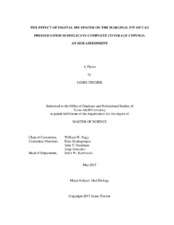| dc.description.abstract | The purpose of this in vitro study was to evaluate the marginal fit of pressed IPS e.max copings fabricated from a computer-aided designed and milled PMMA acrylic resin burnout coping of various cement spacer thicknesses. Three groups of ten PMMA acrylic burnout copings were designed and milled utilizing computer-aided software for a total sample size of thirty copings. Each group differed only by the die-spacer parameters indicated within the design software. Group 1, Group 2, and Group 3 were digitally designed with 25, 40, and 60 μm of die-spacer respectively.
All acrylic resin copings were pressed with IPS e.max lithium disilicate and adhesively bonded to thirty identical epoxy resin dies. Cross-sections of each specimen were obtained and viewed with a scanning electron microscope. Direct measurements were obtained at five pre-determined locations and data analyzed using statistical analysis software.
An analysis of variance (ANOVA) followed by a Mann-Whitney test was used to indicate significant differences between groups (p ≤ 0.017). A statistically significant difference was found between groups for each measured location: buccal margin (p=0.005), buccal-axial (p=0.013), mid-occlusal (p=0.030), lingual-axial (p=0.022), lingual margin (p=0.005).
When 60 μm of die spacer was utilized in the fabrication of the milled acrylic resin coping, the definitive bonded ceramic coping yielded the best marginal fit. Cement thickness was greatest, and marginal fit was poorest when 25 μm of die spacer was utilized. Observed differences between groups can be attributed to the utilization of acrylic resin patterns in the fabrication of pressed IPS e.max copings.
The obtained results suggest that appropriate die spacer parameters indicated within computer-aided design software are critical in the fabrication of clinically acceptable indirect restorations. | en |


